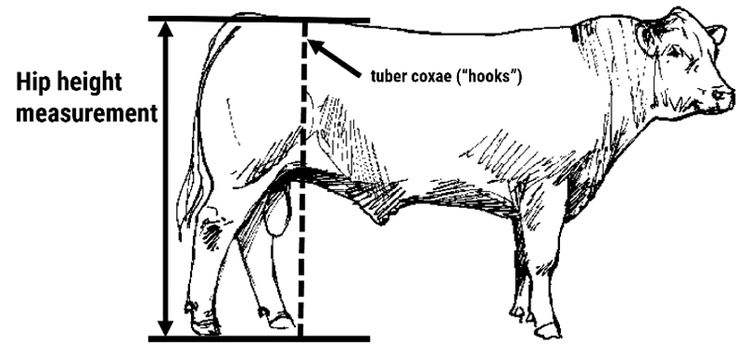



Do beef cattle frame scores need updating?
I heard a seedstock breeder recently quip, “my father used to say, ‘don’t make too many breeding mistakes, because a lifetime may not be long enough if you do’.” If we are not keenly aware of the rapid speed of genetic change occurring within our selected breed(s), we may indeed be destined to make costly breeding mistakes.This rings especially true with beef cattle stature, as it is one of the most heritable traits under our control. Hip height at a given age, converted to a 1 to 10 scale frame score, has been used since the 1970s to estimate the growth curve and resulting mature skeletal size of beef cattle (Figure 1). Although height increases with age, most animals maintain a constant frame score during their lifetime. Frame score has assisted breeders in determining how large a replacement heifer will become as a mature cow or the projected harvest weight of feeder steers and heifers.
Today’s cattle, however, are distant relatives of the 1970s cattle that were used to develop frame score standards. A few seasoned commercial cattlemen I know recently shied away from buying bulls of less than a frame score of 6.5. As a Michigan State University Extension beef specialist and MSU associate professor, I believe these cattlemen should update their use of frame score.
Seedstock breeders and their commercial customers should have a primary focus on weight. This is because paychecks are based on weaning or carcass weight, and maintenance cost is directly related to mature cow weight. Traditionally, frame score has been used as a useful predictor of future weights at puberty, harvest, and maturity. However, my observation is that cattle weight to height ratio is changing fairly rapidly.
Breeders have successfully bent cattle growth curves. That is, they have sought animals that uncouple the strong positive correlations of birth, weaning, yearling, and mature weights. For generations of cattle, breeders have purposefully selected breeding stock with relatively light birth weights to facilitate calving ease. At the same time, they have placed selection pressure on heavy weaning and yearling weights, to produce growthy cattle capable of a large weaning weight and quickly achieving their finished endpoint. I also suspect that many breeders cull some of their potential replacement heifers because they “have too much frame,” but fewer breeders cull those that are “too heavy.”
Changes in frame score and weight for bulls registered with the American Angus Association, over the last 47 years, are graphed in Figure 2, which illustrates weight to height relationship changes. Similar to other breeds, Angus bulls during the 1970s and 1980s were being selected for increased stature. Frame scores leveled during the 1990s, and have declined thereafter.
Interestingly, there has been a steady decline in frame score over the past 20 years that has also been accompanied by a continued increase in yearling weight. Angus cattle (as well as other breeds) are getting deeper and wider. We are all enamored with the “thick one” in the pen and strive to put more muscle on the same frame. Cattle weight to height ratio is increasing based on these selection pressures. The 5.5 frame score yearling Angus bull of today is 150 pounds heavier than the same frame size bull of the mid-1980s. Because weights are highly heritable, this means daughter mature weight is also creeping upward. Indeed, Angus cow mature weights have crept up by more than 100 pounds since the mid-1980s..png)
What do these changes mean for the use of frame score? Frame score is just as useful as it was in 1972. However, our prediction of weight at puberty, harvest, and maturity must be adjusted upward, at a particular frame score, based on today’s cattle phenotype. Average dressed steer weights, as reported by the Livestock Marketing Information Center, have been hovering around 875-900 pounds in the U.S. Thus, we are already on the edge of experiencing hefty discounts that most packers impose for 1,000-1,050 pounds carcass weights.
If our mindset is that selections must come from the upper end of the frame score scale, we risk producing discounted carcasses and cows that have a higher annual maintenance cost. In fact, the Beef Improvement Federation Guidelines now state, “predictions of expected carcass weights or mature cow weights based on these frame scores that appear in many publications are likely incorrect today.”
Academia needs to work on updating these weight prediction tables. In the meantime, commercial cattlemen need to visually recalibrate frame score expectations and remain focused on overall production goals. Commercial selection should focus on easy calving of a vigorous bull calf, capable of fast growth until reaching an acceptable carcass weight, and a heifer contemporary that is capable of returning to the cow herd with an acceptable mature weight and relatively low maintenance cost.
Holding on to historic notions of frame score could lead to costly breeding mistakes.



